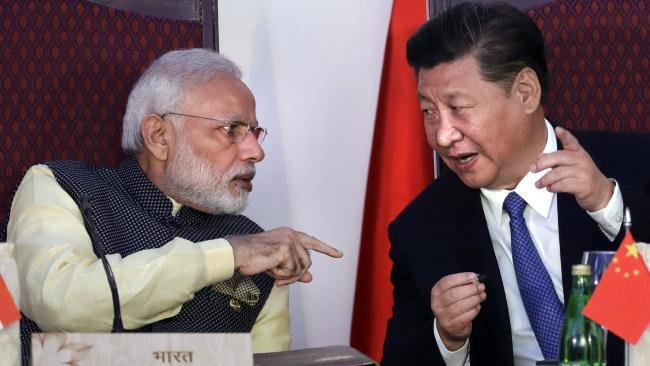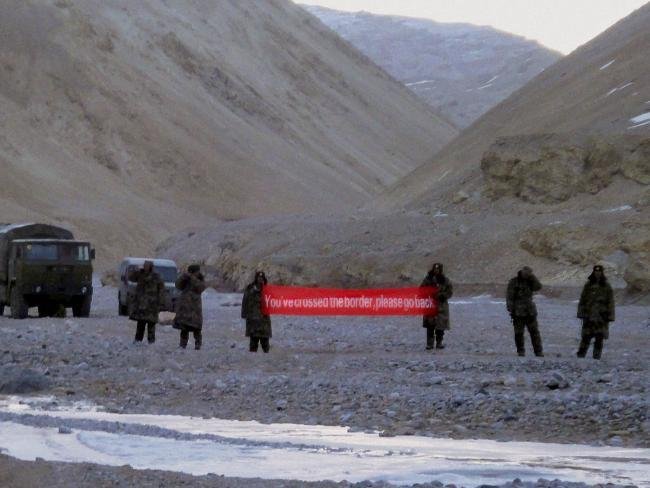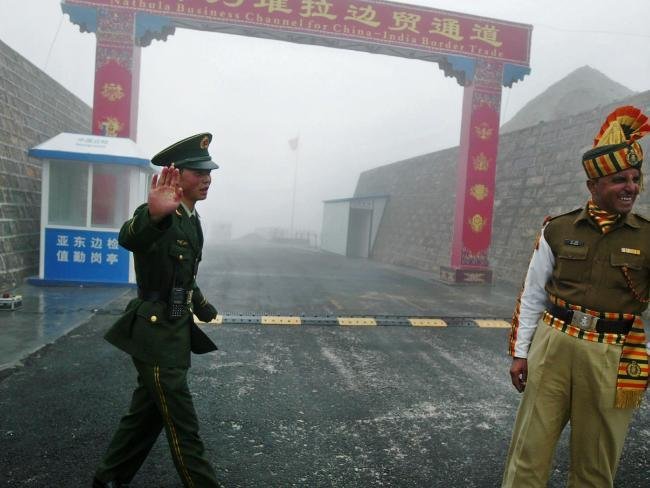China has warned India it is willing to defend territory “at all costs” and it should not harbour any “unrealistic illusions” over a border dispute that threatens to boil over into an open conflict.
The world is watching as the two regional rivals are also nuclear armed nations.
This week China’s Ministry of National Defense spokesman Wu Quian said Chinese border troops would step up “targeted deployment and training” in a remote region between the two countries.
He said India “should not leave things to luck and not harbour any unrealistic illusions” about China’s commitment to defending its territory or push it with the People’s Liberation Army (PLA).
“Shaking a mountain is easy but shaking the PLA is hard,” he said.
The two countries remain locked in a bitter standoff over the Doklam Plateau, known as Donglang in China which is run by Bhutan. India supports Bhutan’s claim over the land, however Chinese soldiers recently arrived to build a mountain road in the area that India fears could leave it vulnerable.
After Chinese bulldozers moved in, India sent troops to evict them, leading to video leaked online of soldiers shoving one another. The US is now urging both sides to work together to prevent what could become a major regional dispute.
Leaked video footage aired on Indian television


OLD WOUNDS
The area was the site of a bloody war in 1962 that ended up with China seizing control of some of the territory. Troops from both sides still regularly patrol other unmarked territories, though neither side has fired any shots in decades. Negotiations since 1985 to settle the boundary dispute have seen little success.
The land they’re arguing over spans 269 square kilometres on a sparsely populated plateau in western Bhutan, which has no diplomatic ties with China and coordinates its relations with Beijing through New Delhi.
But India and China have rival claims to other Himalayan areas as well, including 90,000 square kilometres in what India considers its state of Arunachal Pradesh and China refers to as “Southern Tibet,” as well as 38,000 square kilometres of another plateau called Aksai Chin.
Bhutan said the road China has been building would run from the town of Dokola to the Bhutanese army camp at Zompelri.
Bhutan’s foreign ministry called it a “direct violation” of agreements reached in 1988 and 1998 to maintain peace and refrain from unilateral action in the area pending a final border settlement. “Bhutan hopes that the status quo in the Doklam area will be maintained,” it said in a June 29 statement.
Chinese foreign ministry spokesman Lu Kang said last week that India’s border guards, in responding to Bhutan’s call for help, had “illegally trespassed the boundary into Chinese territory” when they confronted the Chinese army construction team.


‘THE CHICKEN’S NECK’
The Doklam Plateau is a strategic area for India, essential to maintaining its control over a land corridor known as the “chicken’s neck” that connects India’s mainland with its remote northeastern states.
India has said the Chinese road project threatens its access to the corridor, while China has questioned why India should even have a say in a matter that concerns only Beijing and Bhutan.
India’s army chief warned earlier this month that India’s army was capable of fighting “2 1/2 wars” if needed to secure its borders.
Indian analysts said China appeared to be trying to pre-empt settlement negotiations by establishing a Chinese presence in Doklam.
“China has been trying for a long time to gain a tactical advantage in this sector,” having already established dominance along the Indian borders at Ladakh and Arunachal Pradesh, said security expert Uday Bhakar, a retired Indian navy officer.
“The Chinese did not expect this resolute Indian response, and that’s why the standoff has continued.”
The dispute was discussed briefly without resolution by Chinese President Xi Jinping and Indian Prime Minister Narendra Modi on the sidelines of the G20 summit earlier this month in Hamburg, Germany.

UNEASY NEIGHBOURS
The Doklam standoff is the latest of many irritants dogging relations between the world’s two most populous nations.
For years, India has watched uneasily as China vigorously wooed Bhutan and other, smaller countries in India’s traditional sphere of influence, including Nepal, Sri Lanka and Myanmar.
“This is not the first time that we have a standoff with China,” said foreign affairs analyst and retired Indian diplomat G. Parthasarthy, predicting there would likely be a period of stalemate followed by a political compromise if the current tensions follow past patterns.
“China is in an ultranationalist mood of establishing a hegemony power in Asia,” he said. “The best thing for China is to sit down and talk.”
China, meanwhile, has been frustrated with India’s refusal to sign onto a massive effort to build railways, ports and roads reaching from Asia to Europe and the Middle East.
The project includes a China-Pakistan economic development program aimed at absorbing as much as $46 billion in investment, most of it from Chinese banks.
China also has complained bitterly for decades over India’s accepting the Dalai Lama as a refugee in 1959.
The Tibetan Buddhist spiritual leader has kept his headquarters in northern India since fleeing Chinese-ruled Tibet. Despite their disagreements, India and China entered a trade agreement in 1985 and have stepped up co-operation in agriculture, science and cultural exchange.
But a $46.6 billion trade deficit favouring China has irked Indian members of parliament, who call regularly for more balance.
Online Source: news.com